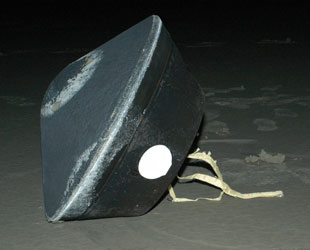September 26, 2008 — A NASA capsule that collected the first samples from a comet is about to become part of a collection itself.
NASA's Stardust sample return capsule, which completed a seven year, three billion mile round-trip to comet Wild 2 in 2006, will join the national collection at the Smithsonian National Air and Space Museum in Washington, DC. The capsule is set to debut on public display in the museum's Milestones of Flight gallery on October 1, NASA's 50 year anniversary.
"Very few people get to build something, launch it into space, see it be successful and then get it back in their hands," said Karen McNamara, Johnson recovery lead for the Stardust mission. "To be able to share this with the public is phenomenal."
Stardust, comprising both a spacecraft and capsule, used its tennis racket-like, aerogel-lined collector to capture particles as it came within 150 miles of Wild 2 in January 2004. Carrying the samples, the capsule returned to Earth on January 15, 2006, landing in Utah. Two days later, it was transported to a curatorial facility at NASA's Johnson Space Center in Houston.

NASA's Stardust sample return capsule as it was found after landing at the U.S. Air Force Utah Test and Training Range on January 15, 2006. (NASA) |
The capsule will be exhibited in the same hall as Charles Lindbergh's Spirit of St. Louis, John Glenn's Friendship 7 and the Apollo 11 command module Columbia that carried the first men to walk on the moon.
"The Smithsonian Institution's National Air and Space Museum is delighted to add to the National Collection the Stardust return capsule," said Roger Launius, senior curator of the Division of Space History. "As one of the premier space science missions of the recent past, Stardust will take its place alongside other iconic objects from the history of air and spaceflight. I look forward to helping to impart more knowledge to our visitors about the makeup of the universe using this significant and path breaking object."
The hardware provided to the Smithsonian includes actual flight components. Elements that remain relevant to the on-going science goals of the mission remain with NASA.
The capsule's spacecraft, with which it flew to Wild 2, is still in space. Having successfully completed its mission, it will visit comet 9P/Tempel 1 to provide the first look at the changes to a comet's nucleus produced after a close approach to the Sun. The new mission, dubbed Stardust NExT will mark the first time a comet has been revisited. It was first visited by the Deep Impact spacecraft on July 4, 2005.
"Usually, when a piece of your spacecraft goes into the Smithsonian that means the mission's over," said Rick Grammier, Stardust-NExT project manager at NASA's Jet Propulsion Laboratory in Pasadena, California. "But the Stardust spacecraft is still doing the job for NASA and in February 2011, it will fly within 120 miles of the comet."
This past April, the Smithsonian awarded the National Air and Space Museum Trophy, the museum's highest honor, to the Jet Propulsion Laboratory, Lockheed Martin Space Systems, and University of Washington team that led the Stardust mission for NASA.
Preceding the capsule's display, samples of aerogel, a solid made almost entirely of air that was used to catch the comet particles, and a flight suit worn by Stardust project manager Thomas Duxbury were exhibited with the trophy at the museum.
